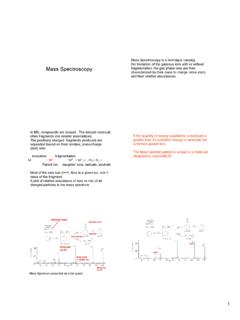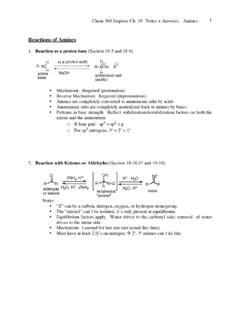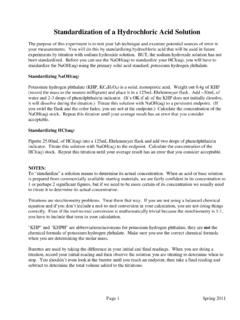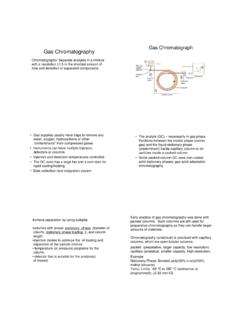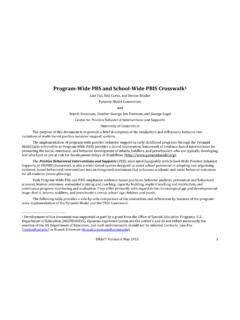Transcription of The Impact of School-Wide Positive Behavioral ...
1 school Psychology Quarterly Copyright 2008 by the American Psychological Association 2008, Vol. 23, No. 4, 462 473 1045-3830/08/$ DOI: The Impact of School-Wide Positive Behavioral Interventions and Supports (PBIS) on the Organizational Health of Elementary Schools Catherine P. Bradshaw, Christine W. Koth, Katherine B. Bevans, Nicholas Ialongo, and Philip J. Leaf Johns Hopkins Center for the Prevention of Youth Violence Positive Behavioral Interventions and Supports (PBIS) is a universal, School-Wide prevention strategy that is currently implemented in over 7,500 schools across the nation to reduce disruptive behavior problems through the application of Behavioral , social learning, and organizational Behavioral principles. PBIS aims to alter school environments by creating improved systems and procedures that promote Positive change in student behavior by targeting staff behaviors.
2 The present study examined the Impact of PBIS on school organizational health using data from a large randomized controlled trial of PBIS conducted in 37 elementary schools. Longitudinal multilevel analyses on data from 2,507 staff revealed a significant effect of PBIS on staff reports of the schools' overall organizational health, resource influence, and staff affiliation over a 3-year period. This study indicated that changes in school organizational health are important consequences of the PBIS whole- school prevention model, and might in turn be a potential mediator of the effect of PBIS on student performance. Keywords: Positive Behavioral interventions and supports, School-Wide prevention, organiza- tional health, school improvement, randomized controlled trial Local school districts, educational research- vide incentives to students meeting expecta- ers, and policymakers are increasingly turning tions, and establish a consistent strategy for to School-Wide preventive interventions such as managing behavior problems.
3 Despite the grow- Positive Behavioral Interventions and Supports ing use and acceptance of PBIS and other (PBIS; Horner, Sugai, Todd, & Lewis-Palmer, whole- school interventions, to date, no longitu- 2005; Sugai & Horner, 2006b) to promote a dinal randomized controlled trials have been Positive school climate and reduce student be- conducted to determine the Impact of PBIS on havior problems. Many of these whole- school the school environment. The present study uses programs systematically manage student behav- a group randomized control trial design to ex- ior by creating School-Wide plans that clearly amine the effect of PBIS training on staff per- articulate Positive Behavioral expectations, pro- ceptions of the school 's organizational health, a characteristic of the school environment that has been linked with Positive student and staff out- comes (Hoy, Tarter, & Bliss, 1990).
4 Catherine P. Bradshaw, Christine W. Koth, Katherine B. Bevans, Nicholas Ialongo, and Philip J. Leaf, Johns Hop- kins Bloomberg school of Public Health, Johns Hopkins School-Wide PBIS. Center for the Prevention of Youth Violence. Support for this project comes from grants from the School-Wide PBIS is a noncurricular univer- Centers for Disease Control and Prevention (R49/ sal prevention strategy that aims to alter the CCR318627, 1U49CE 000728, and K01CE001333-01) and the National Institute of Mental Health (1R01MH67948-1A school environment by creating improved sys- and T32 MH19545-11). We thank the PBIS Maryland State tems ( , discipline, reinforcement, data man- Leadership Team for their support of this project. agement) and procedures ( , office referral, Correspondence concerning this article should be ad- reinforcement, training) that promote Positive dressed to Catherine Bradshaw, Department of Mental Health, Johns Hopkins Bloomberg school of Public Health, change in staff and student behaviors.
5 The pro- 624 N. Broadway, Baltimore, MD 21205. E-mail: gram draws upon Behavioral , social learning, and organizational Behavioral principles (Lewis 462. PBIS AND ORGANIZATIONAL HEALTH 463. & Sugai, 1999; Lindsley, 1992), which were problem. Students across all classrooms receive traditionally used with individual students, and consistent consequences for disciplinary infrac- extends and applies them to the entire student tions. A formal system is developed to collect, body consistently across all school contexts analyze, and use disciplinary data ( , office (Durand & Carr, 1992; Horner, Albin, Sprague, discipline referrals, suspensions) to make deci- & Todd, 1999). PBIS aims to prevent disruptive sions regarding program implementation. behavior and enhance the school 's organiza- Initial results from nonrandomized studies in- tional health by creating and sustaining primary dicate that implementation of PBIS is associated ( School-Wide ), secondary (classroom), and ter- with a reduction in office discipline referrals (Tay- tiary (individual) systems of support.)
6 The three- lor-Greene et al., 1997) and suspensions (Sugai &. tiered prevention model follows a public health Horner, 2006a). There is also preliminary evi- approach, whereby two levels of targeted and dence suggesting that PBIS is associated with selected programs are implemented to comple- sustained changes in schools' internal discipline ment the universal School-Wide components of practices and systems (Bradshaw, Mitchell, &. the model (for a review, see Carr et al., 2002; Leaf, in press; Nersesian, Todd, Lehmann, &. Horner et al., 2005; Sugai & Horner, 2006b; Watson, 2000; Taylor-Greene & Kartub, 2000). Sugai, Horner, & Gresham, 2002). and improved academic performance (Horner et The current paper focuses solely on the uni- al., in press).
7 However, little is known about the versal School-Wide PBIS model that is com- mechanisms through which PBIS has Positive ef- prised of the following seven critical features. A fects. By altering the behavior of the adults in the PBIS team is formed within the school to pro- school , we anticipated that PBIS would have a vide leadership regarding School-Wide imple- Positive Impact on staff members' perceptions of mentation of PBIS. The team, which is com- the school 's overall organizational health, which prised of six to eight staff and an administrator would likely serve as an important mediator of the attends annual training events, establishes an effect of PBIS on student outcomes. action plan for implementing PBIS, develops materials to support program implementation, Hypothesized Effect of PBIS on trains other staff members, and meets monthly Organizational Health to discuss School-Wide behavior management.
8 A Behavioral support coach provides on-site school organizational health is comprised of technical assistance regarding PBIS. The coach the following core features: resource influence, is typically a school psychologist or guidance staff affiliation, academic emphasis, collegial counselor who has prior experience working leadership, and institutional integrity. The var- with PBIS and conducting functional Behavioral ious facets of organizational health are likely assessments. The school team establishes three influenced by PBIS through multiple pathways. to five positively stated School-Wide Behavioral Specifically, with regard to resource influence, expectations regarding student behavior ( , which is defined as the principal's ability to be respectful, responsible, and ready to learn ) lobby for resources and supports for the school that are posted in all classrooms and nonclass- and staff (Hoy & Tarter, 1997), implementation room settings, and are known by all students of PBIS is expected to positively affect the and staff.
9 Plans are developed by the school school 's access to personnel resources ( , staff for defining and teaching the School-Wide Behavioral support coach), professional devel- Behavioral expectations on a regular basis. A opment ( , booster training sessions), and School-Wide system is developed to reward stu- district-level supports. Furthermore, having dents who exhibit expected Positive behaviors. connections to district-level staff through PBIS. school staff establish and use a School-Wide might increase communication between the system for reinforcement that includes a tangi- school and district regarding the school 's needs. ble reinforcer and is used consistently by all With regard to staff affiliation, defined as the school staff across all settings.
10 Staff and admin- sense of warmth, Positive interactions between istrators create an agreed upon system for re- colleagues, and shared commitment to students, sponding to Behavioral violations that includes we anticipated that the PBIS model's emphasis definitions about what constitutes a classroom- on collaboration and joint decision-making managed versus an office-managed discipline would likely foster greater feelings of school 464 BRADSHAW ET AL. bonding, connection, and membership among Taken together, the extant research along all staff (Childers & Fairman, 1986; Tsui & with the PBIS model's emphasis on enhanced Cheng, 1999). More specifically, whereas most organization and altering staff behavior to cre- school -based programs ( , reading initiatives, ate improved systems, supports, and practices curriculum-based social emotional programs) suggests that PBIS would be associated with only affect a subset of staff, PBIS requires the significant improvements in staff perceptions of buy-in of at least 80% of staff and the partici- the school 's organizational context (Sugai &.)

